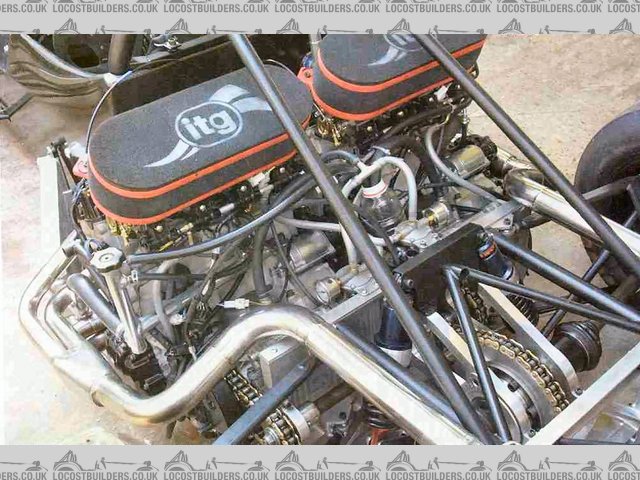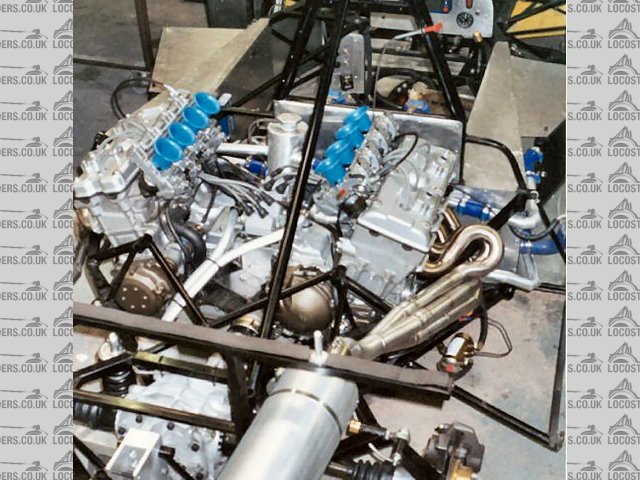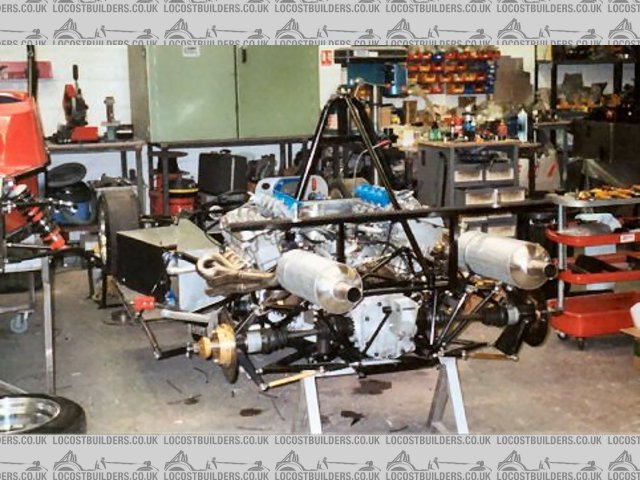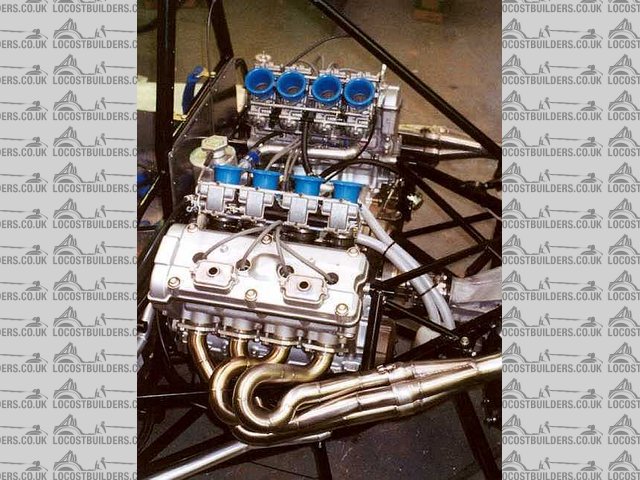
8 cyl chain driven BEC middy?
sgraber - 20/11/04 at 10:58 PM
I threw my back out yesterday so now while I lay in bed with nothing to do I am thinking about novel ways to power cars. Just thinking out loud while
the percocet wears out... 
Looking over the current eBay auctions for Bike engines, the 600cc car kits (complete running engines with intake and exhaust and electrics) can be
had for around $300USD. That's very, VERY inexpensive compared to the 1000cc+ class of engines. At that price I can afford to buy 2 of them...

So I'm trying to think of a suitable (inexpensive yet functional) way to mount two 600cc engines in the back of my car. I actually have room to
mount two of them side by side inline with each other. And on the surface it sounds like a pretty neat idea! My thought is to join the outputs of both
engines via chain/sprockets to an intermediate shaft mounted directly behind the two engines. Another chain drive transfers power from the
intermediate shaft to the differential.
I had originally thought about placing the engines parallel to each other but facing outwards from each other, chain driving a common jack-shaft
between them. The shaft mated to a car differential. However, in this configuration one of the engines would have to have its output reversed... So I
would need to fabricate a rotation reversing gearbox... $
Back to the first idea (inline 8 cylinder 1,200cc)... Is the weight penalty and the increased complexity the reason that this is not done very often?
I think I might like the sound of 8 cylinders revving to 13K rpms!
It honestly doesn't sound like a very complex project. Maybe a 40Kg (est) weight penalty for the additional gearbox and the additional
chain/sprocket drive?
Rorty - 20/11/04 at 11:35 PM
Just do it! Here are some pics for inspiration. In the first one, the jack shaft and diff are mounted ecentrically to adjust the chains.
[Edited on 20/11/04 by Rorty]


Rescued attachment Force_Duel_drivetrain.jpg
Rorty - 20/11/04 at 11:36 PM
No.2


Rescued attachment ZX9_V8_01.jpg
Rorty - 20/11/04 at 11:37 PM
No.3


Rescued attachment ZX9_V8_02.jpg
Rorty - 20/11/04 at 11:41 PM
No.4. These last three pics are of twin Kawasaki ZX9 engines.
Notice how much wider the "V8" configuration is compared to the 8 in-line set-up.
[Edited on 20/11/04 by Rorty]


Rescued attachment ZX9_V8_03.jpg
krlthms - 20/11/04 at 11:54 PM
In pics #2 and 3 it looks though both engines are running of a single ignition system. Is this a tru V8? Do each engine have seperate gear box and
crank. The istallatuion looks very beautiful, and I am sure sounds great.
Mr Rorty, do you have any more details on this car?
Cheers
Karl
Rorty - 21/11/04 at 12:00 AM
Karl, The two bike engines do remain intact but do share the final drive.
I'll see if I can find the details of it all. My memory of it is sketchy, but there are definitely gears involved in the final drive as opposed
to solely chains.
sgraber - 21/11/04 at 12:08 AM
Wow Rorty! You are the MAN! 
I love the look of the 2nd setup, The v8 look is incredible!
But I believe that the car in the first photo is of a setup that is more attainable by the home builder. Do you have any more information about the
car in the first image? More photos?
Any thoughts on the use of the smaller engines? Torque issues? Things that make you go Hmmm?
Graber
krlthms - 21/11/04 at 12:29 AM
quote:
Originally posted by Rorty
Karl, The two bike engines do remain intact but do share the final drive.
I'll see if I can find the details of it all. My memory of it is sketchy, but there are definitely gears involved in the final drive as opposed
to solely chains.
This setup would look in your Beetle
Cheers
Karl
krlthms - 21/11/04 at 01:24 AM
The word good was missing from my last post
Rorty - 21/11/04 at 01:31 AM
quote:
Originally posted by sgraber
Wow Rorty! You are the MAN! 
I love the look of the 2nd setup, The v8 look is incredible!
But I believe that the car in the first photo is of a setup that is more attainable by the home builder. Do you have any more information about the
car in the first image? More photos?
Any thoughts on the use of the smaller engines? Torque issues? Things that make you go Hmmm?
Graber
I agree, the method of hook-up in the first shot is so simple, just sound agricultural engineering attainable by anyone, and more to the point, very
cheap.
The "smaller" engines have very respectable power outputs these days of between 100 and 120 hp, but the torque figures are obviously quite
low due to the small pumping effect of of only 600cc. Around 40 ft-lbs is the average figure.
A single 600 sportsbike engine in a sub 400kg car drives a bit like your old 250cc dirt bike...it's like a two-smoke and you have to rev its guts
out to make it get up and go. They're bloody quick and good fun once they're going mind you.
However, if you're going to fit two of the little beasties into a car, then you've got around 80 lb-ft of torque..similar to the big 1100cc
and 1300cc sportsbike motors. Now you're rocking!
The combined weight would be somewhat more than a single large capacity engine, but not by much and at that price, there's no comparrison.
I have more twin-engine related pics on a CD somewhere. If I can find them, I'll post them on here.
A large capacity twin-engined mid-mounted Beetle chassis IS on the books. 
scoobyis2cool - 21/11/04 at 02:11 AM
I'm sure this has been resolved before but just something I was thinking about...
If you have 2 engines directly linked via a chain, that obviously means that both engines must be turning at exactly the same speed. How do you
control this? Does it just work itself out naturally, with the faster engine 'dragging' the slower one up to the same speed? Or do you need
some other, more complicated method that would add cost and weight?
Just a thought...
Pete
Rorty - 21/11/04 at 02:34 AM
I think when Volkswagen built their twin engined (one up front) Beetle for desert duties in the North African campaign they may have had sync problems
and possibly Citroen did too with their twin-engined 2CV. The modern sportsbike engines are like Swiss watch movements, so all that's necessary
is to sync all eight carbs (on carb engines) and away you go. Very quickly! 
sgraber - 21/11/04 at 03:57 AM
quote:
Originally posted by scoobyis2cool
I'm sure this has been resolved before but just something I was thinking about...
If you have 2 engines directly linked via a chain, that obviously means that both engines must be turning at exactly the same speed. How do you
control this? Does it just work itself out naturally, with the faster engine 'dragging' the slower one up to the same speed? Or do you need
some other, more complicated method that would add cost and weight?
Just a thought...
Pete
Since the engines are linked physically by the chains, I suppose that having them both set to #1 TDC before linking them would be a good idea (or
maybe not?) Good question. A better method would be to have the #1 cylinder of one engine at TDC on compression stroke and the other at TDC of exhaust
stroke? Or is there some other synchronization setting that would develop a more even power delivery?
In any case I would assume that if the engines are tied together with a chain (even though it is out past the transmissions) then that is almost like
having a common crankshaft, as long as they are in the same gear they should maintain perfect synchronization.
A EFI pair of motors should probably use an aftermarket computer capable of controlling fuel and spark to 8 cylinders. Megasquirt anyone?
Rorty - 21/11/04 at 04:18 AM
quote:
Originally posted by sgraber
Since the engines are linked physically by the chains, I suppose that having them both set to #1 TDC before linking them would be a good idea (or
maybe not?) Good question. A better method would be to have the #1 cylinder of one engine at TDC on compression stroke and the other at TDC of exhaust
stroke? Or is there some other synchronization setting that would develop a more even power delivery?
In any case I would assume that if the engines are tied together with a chain (even though it is out past the transmissions) then that is almost like
having a common crankshaft, as long as they are in the same gear they should maintain perfect synchronization.
The first time the clutch is used, they'll be out of sync. It's really not a problem with these motors. They're amuch more
sophisticated and infinitely better internally balanced than 99% of road-going car engines. The fact they can safely rev to @ 13,000 RPM says it all.
Rorty - 21/11/04 at 04:37 AM
I looked through my records and all I can turn up so far is the owner of the twin ZX9-engined hillclimb car is a bloke called Steve Owens from
(Surrey?) in England..definitely England.
Here's another pic of it:


Rescued attachment ZX9_V8_04.jpg
JoelP - 21/11/04 at 09:34 AM
good thread. im still thinking about the best way (read easiest!) to link two bike engines. trouble is, there are so many ways.
my favourite idea is to have the two engines lengthwise, and facing opposite directions. the n/s engine turning a central jackshaft (like a prop, but
just on a bearing at the front) via a chain, and the o/s engine turning it via a pair of cogs/gears, because its spinning the wrong way by pointing
forward. these turning a rear diff. the plus side of this is that both exhausts point out. if you have both engines with the sprockets pointing
backwards, its easier to join up but the n/s carb is quite close to the o/s exhaust.
im gonna start fiddling with test chassis quite soon, maybe just knocking up a back end to hang everything on. my planned back end would be dedion,
for simplicity of mounting it.
Rorty - 21/11/04 at 11:34 AM
quote:
Originally posted by JoelP
my favourite idea is to have the two engines lengthwise, and facing opposite directions. the n/s engine turning a central jackshaft (like a prop, but
just on a bearing at the front) via a chain, and the o/s engine turning it via a pair of cogs/gears ...
That's exactly how the "V8" set-up above works...near side engine drives the jack directly and the off side engine drives indirectly
through two gears.
In theory, the off side engine would be losing a little bit of power to the gears, but I doubt if that would really matter in the grand scheme.
JoelP - 21/11/04 at 06:05 PM
on a recent link, someone dropped the altenator off the engine that went through most transmission loss. might even things up abit. Twas a twin zx9,
150bhp on one engine and 154 on the one without the altenator.
JoaoCaldeira - 23/11/04 at 05:14 PM
Hi all.
Very good thread.
And how about a missed gear change?
One engine would then push the not changed engine beyond it's possibilities, right?
This could only be overrided with a "smart box" that would change and check if the gear was correctly changed or a common gearbox...
Joćo Caldeira
JoelP - 23/11/04 at 07:12 PM
twin revcounters or a good ear would solve this one! IIRC, this was why the tiger had two gear levers, so that they could be corrected if they ended
up in different gears. i reckon some springs and a bit of fiddling would solve it.
type r1 - 23/11/04 at 08:14 PM
why can't you have the 2 engines transverse, like in the bike, and next to each other and use a chain from each engine to drive a single rear
wheel each. almost like having 2 bike rear ends next to each other at the back of the car. then you don't need the extra gearing to join the 2
power outputs and you have almost zero transmission loss because you're not using a diff.
what do you think?
dom.
[Edited on 23/11/04 by type r1]
JoelP - 23/11/04 at 08:39 PM
i think it would be like using a very open diff, extreme wheel spin in cornering. might not be the case, feel free to correct me!
Rorty - 23/11/04 at 08:52 PM
quote:
Originally posted by type r1
why can't you have the 2 engines transverse, like in the bike, and next to each other and use a chain from each engine to drive a single rear
wheel each. almost like having 2 bike rear ends next to each other at the back of the car. then you don't need the extra gearing to join the 2
power outputs and you have almost zero transmission loss because you're not using a diff.
Imagine what would happen if one of the engines had a misfire or fuel blockage at speed on the motorway. 

krlthms - 23/11/04 at 09:22 PM
Look at this site:
http://www.just-the-one.net/index.html
under the FAQ section. It states that this car can be driven with one engine in 2nd gear while the other engine is in 6th!
Cheers
Karl
sgraber - 23/11/04 at 09:45 PM
Looking at that Tiger Site - Maybe it would be easier to oppose the engines with a center jack-shaft and reverse the rotation of the right side engine
with a constant mesh two gear transfer box.

Like the photo above except one input and one output both on the same side of the case. Could it be fabbed using 2 identical gears sourced from
automotive transmissions and a custom gearcase?
JoelP - 23/11/04 at 09:52 PM
hey steve, theres a thread in tools and techniques that you need to see!
http://www.locostbuilders.co.uk/viewthread.php?tid=19413
this is exactly what we are discussing! word for word! ive just posted a piccy too...
word for word! ive just posted a piccy too...

stevebubs - 24/11/04 at 11:23 AM
Missmatched Gearchange is exactly how Tiff blew one of the Z-Cars Twin-Engined jobbies
robinho - 24/11/04 at 12:30 PM
From what I hear Mr Needell has a reputation for being somewhat hard on cars in any case!
Rorty - 24/11/04 at 08:35 PM
I know of several twin engined race cars that see regular abuse on the track, and I've never heard of them having gear troubles.
I think if the installation is done well with quality linkages etc, there shouldn't be a problem.
















